Lawson M.V. Finite Automata
Подождите немного. Документ загружается.

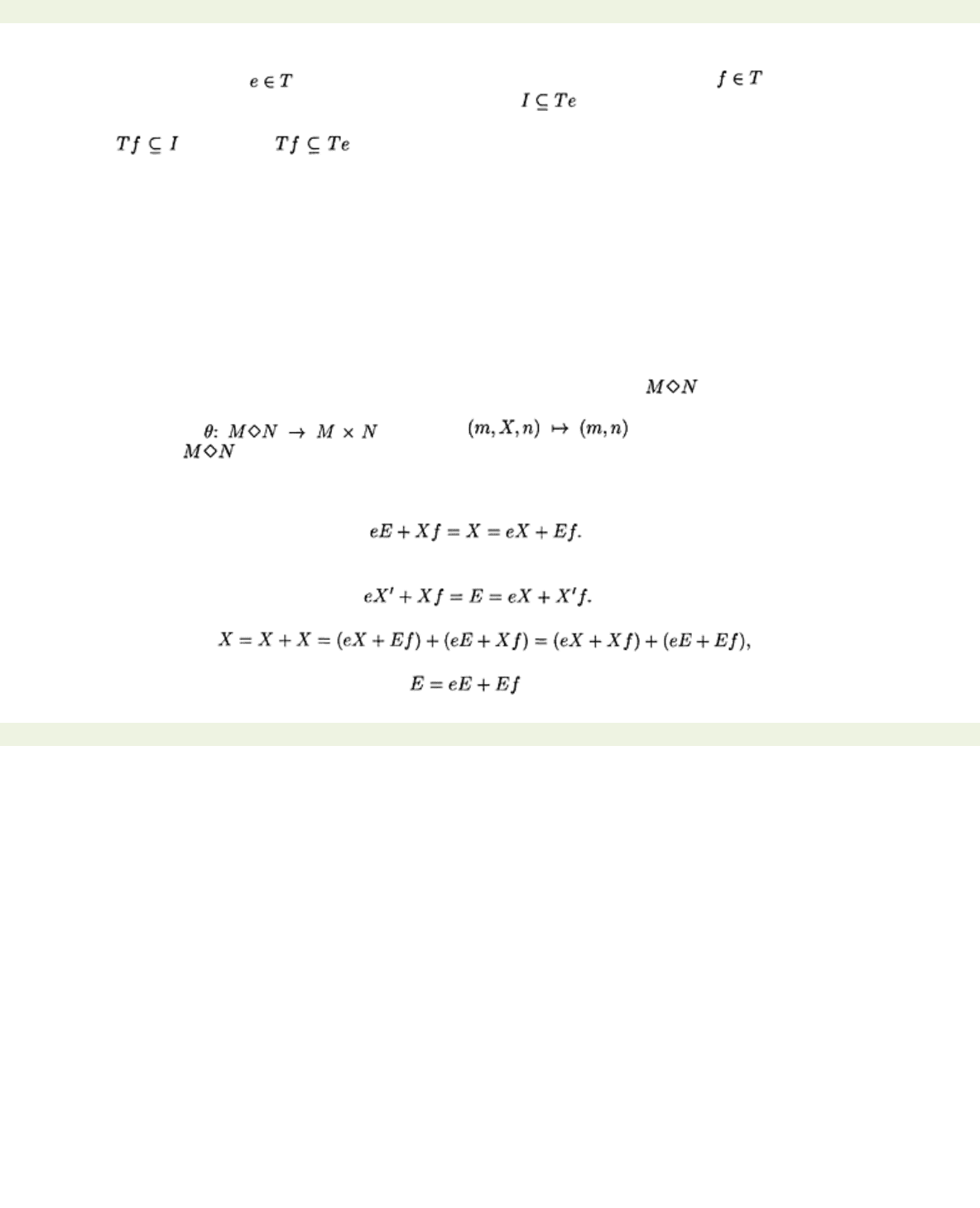
< previous page page_247 next page >
Page 247
Theorem 10.1.2. Choose
an idempotent such that for every idempotent we have that |
Te
|
≤|
Tf
|. We claim that
Te
is a minimal left ideal in
T
. Let be a non-empty left ideal in
T
. Then
I
is
in particular a finite subsemigroup and so contains an idempotent
f
. Because
I
is a left ideal of
T
we
have that
. But then . It follows that
Tf
=
Te
and so
I
=
Te
. By Proposition 11.2.14, we
have that
G
=
eTe
is a group in
T
and so in
S
. Now let
H
be the subgroup of
S(Y)
generated by the
permutations induced by elements of
S
on the set
Y
. Define
α: G
→
H
by
α(a)
=
fa
where
fa
is the
permutation on
Y
induced by
a
. This is clearly a surjective homomorphism.
(iii) If
G
is a non-trivial group in
S,
then the claim follows by (i). Conversely, suppose that the conditions
of the claim hold. Then the result follows by (ii).
The result in (iii) above is important, because it enables us to connect our conjecture of Section 11.1
with the definitions of this section. Specifically the presence or absence of groups in a transition monoid
is the same as the presence or absence of elements inducing non-trivial permutations on subsets of the
set of states. The conjecture at the end of Section 11.1 can now be rephrased as follows: a language
over a one-letter alphabet is star-free iff its syntactic monoid contains no groups.
Finally, we characterise groups in Schützenberger products.
Proposition 11.2.16
Let M and N be monoids. Then every group in is isomorphic to a group in
M
×
N
.
Proof The function given by is a homomorphism. Let
(e, E, f)
be
an idempotent in . Then
e
is an idempotent in
M, f
is an idempotent in
N,
and
eE
+
Ef
=
E
. It follows
by Lemma 11.2.13 that
θ
maps
H(e, E, f)
to
H(e, f)
. We use Proposition 11.2.7 to prove that
θ
is
injective. Suppose there is an element in
H(e, E, f)
that maps to
(e, f)
. Such an element is of the form
(e, X, f),
where
We prove that
(e, X, f)
must be
(e, E, f)
. By assumption,
(e, X, f)
is invertible in
H(e, E, f)
so there
exists an element
(e, X′, f)
such that
Now
but
< previous page page_247 next page >
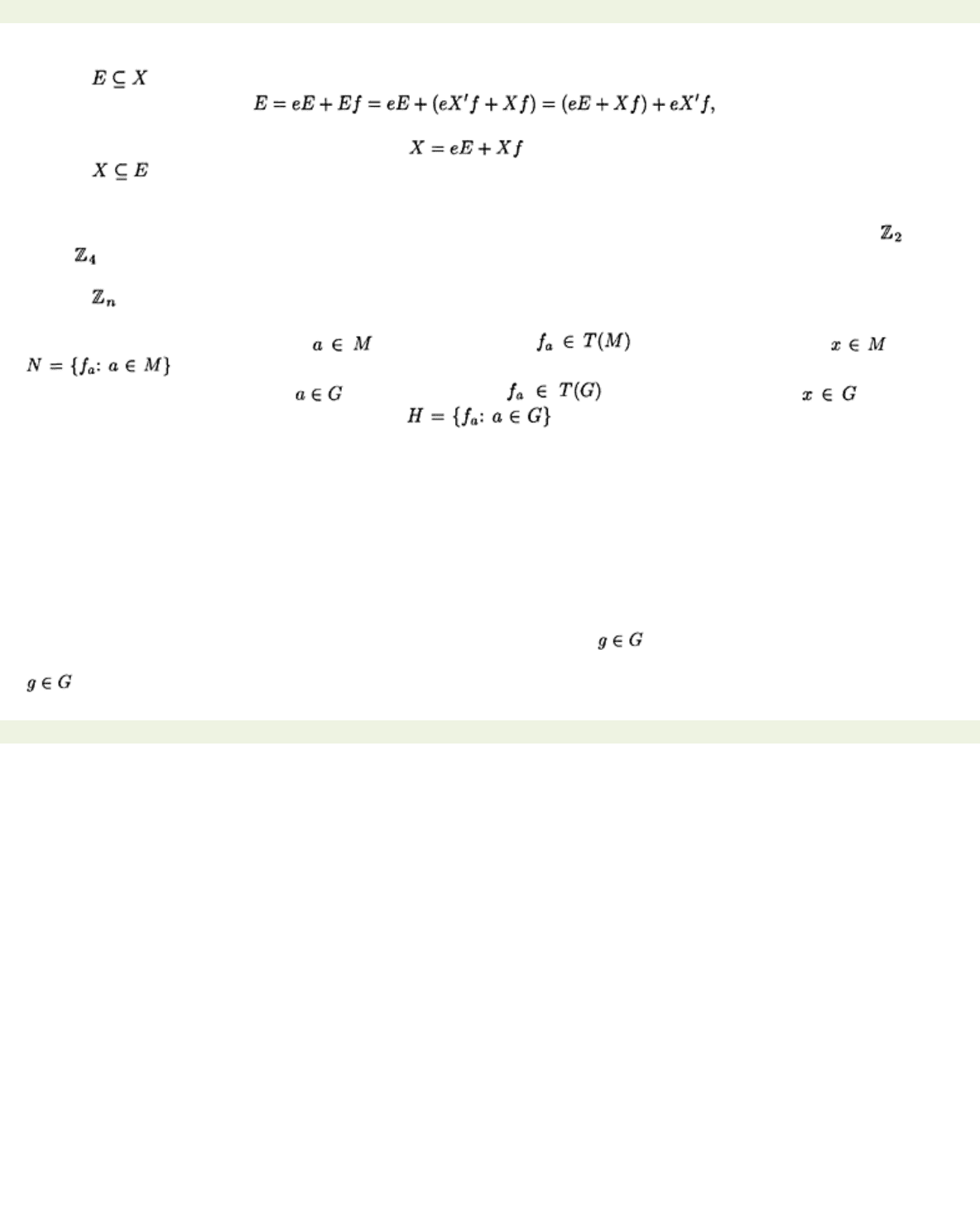
< previous page page_248 next page >
Page 248
and so
. Also,
but
and so . Hence
E
=
X,
as required.
Exercises 11.2
1. Draw up Cayley tables for
S
2 and
S
3.
2. Prove that if
G
and
H
are groups then
G
×
H
is a group. Show that the product of the groups ( , +)
and ( , +) is not cyclic.
3. Find all the maximal subgroups in
T
3.
4. Let ( , ×) be the monoid of integers modulo
n
under multiplication. Prove that an element is
invertible if and only if it is coprime to
n
.
5. Let
M
be a monoid. For each define a function by
(x)fa
=
xa
for each . Let
. Show that
N
is a sub-monoid of
T(M)
and that
M
is isomorphic to
N
.
6. Let
G
be a group. For each define a function by
(x)fa
=
xa
for each . Show
that
fa
is a permutation of
G
. Deduce that is a subgroup of
S(G)
. Show that
G
is
isomorphic to
H
.
7. Show that the only idempotent in a group is the identity. Now let
S
be a finite monoid with exactly
one idempotent. Prove that
S
is a group.
The second result is not true for infinite monoids. For example, A
*
is a monoid with exactly one
idempotent, but it is not a group
.
8. Let
α: S
→
G
be a homomorphism from the finite semigroup
S
onto the finite group
G
. Show that there
is a group
H
in
S
such that
α(H)
=
G
.
9. Let
S
and
T
be semigroups. Show that each maximal group in
S
×
T
is of the form
G
×
H,
where
G
is a
maximal group in
S,
and
H
is a maximal group in
T
.
10. Let
ρ
be a congruence on a group
G,
and put
N
=
ρ
(1).
(i) Prove that
N
is a subgroup of
G
and that
g
−1
Ng
=
N
for each .
(ii) Prove that the admissible partition associated with
ρ
has as blocks the subsets of the form
Ng
where
.
< previous page page_248 next page >
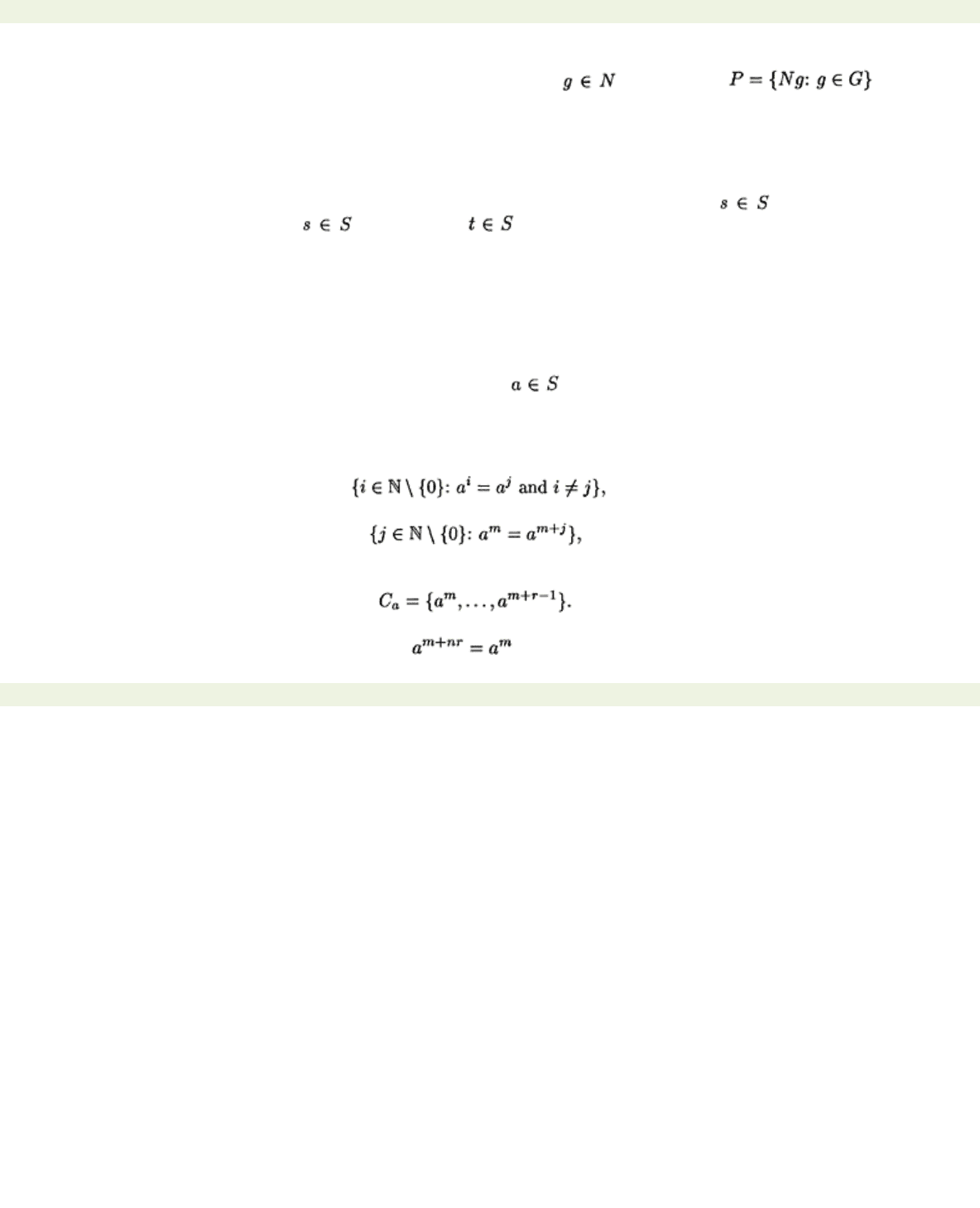
< previous page page_249 next page >
Page 249
Now let
N
be any subgroup of
G
such that
g
−1
Ng
=
N
for all . Prove that is an
admissible partition of
G
.
Subgroups N satisfying the condition above are said to be
normal.
The results of this question show that
each congruence on a group determines and is determined by a normal subgroup of G. This means that
in group theory we need only work with normal subgroups rather than with the congruences they
determine.
11. Let
S
be a semigroup that contains an element
e
such that
se
=
s
for each . In addition,
suppose that for each element
there exists such that
st
=
e
. Prove that
S
is a group with
identity
e
.
11.3 Aperiodic semigroups
At the end of Section 11.1, we highlighted the absence or presence of groups in a syntactic monoid as
being crucial in determining whether the corresponding language was star-free or not. In Section 11.2,
we investigated groups in semigroups in general. In this section, we shall characterise those semigroups
all of whose groups are trivial. The key step in our characterisation will be an investigation of the sorts
of semigroups that can be syntactic monoids of recognisable languages over one-letter alphabets.
Theorem 11.3.1
Let S be a finite semigroup, and let be an arbitrary element. Then there are
positive integers m and r such that the elements a
1
,…, am,…, am
+
r
−1
are distinct, but am
+
r=am
.
Furthermore, the elements Ca
=
{am,…, am
+
r
−1
} form a cyclic group of order r in S
.
Proof Consider the subsemigroup
a
+=
{a, a
2
,…}
. Because
S
is finite there must be a power of
a,
say
ai,
which is repeated later on, say
ai
=
aj
where
i
≠
j
. Thus the set,
is non-empty, and so has a smallest element which we denote by
m
. The set,
is therefore non-empty, and so has a smallest element which we denote by
r
. By construction the
elements
a
1
,…, am
+
r
−1 are distinct. Put
From
am
=
am
+
r
and induction, we deduce that
< previous page page_249 next page >

< previous page page_250 next page >
Page 250
for all . Let
s
≥
m
be any number. By the Remainder Theorem, we may write
Thus
It follows that
Ca
is a subsemigroup of
S
. We show that
Ca
is a cyclic group in
S,
and to do this we
shall use the group (
, +). Define by
θ(am
+
i)
=
i′,
where and
i′
=
m
+
i
(mod
r
). The
numbers
m,…, m
+(
r
−1) are
r
consecutive numbers and so are congruent modulo
r
to the numbers 0,…,
r
−1 in some order. Thus
θ
is a bijection. We show that it is a homomorphism. Let 0≤
i, j
≤
r
−1. Then
where
It follows that
Let
m
+
i
+
j
=
qr
+
u
where
u
<
r
. Then
Thus
It follows that
But
and
Thus
i′
+
j′
=
m
+
u
(mod
r
). Hence
θ
is a homomorphism, and so an isomorphism of semigroups. But a
semigroup isomorphic to a group is itself a group. Thus
Ca
is a group isomorphic to under addition.
Let
S
be a finite semigroup and . Then the number
m
is called the
index of a
and the number
r
is
called the
period of a
.
We can now return to the question of when a semigroup contains only trivial groups.
< previous page page_250 next page >
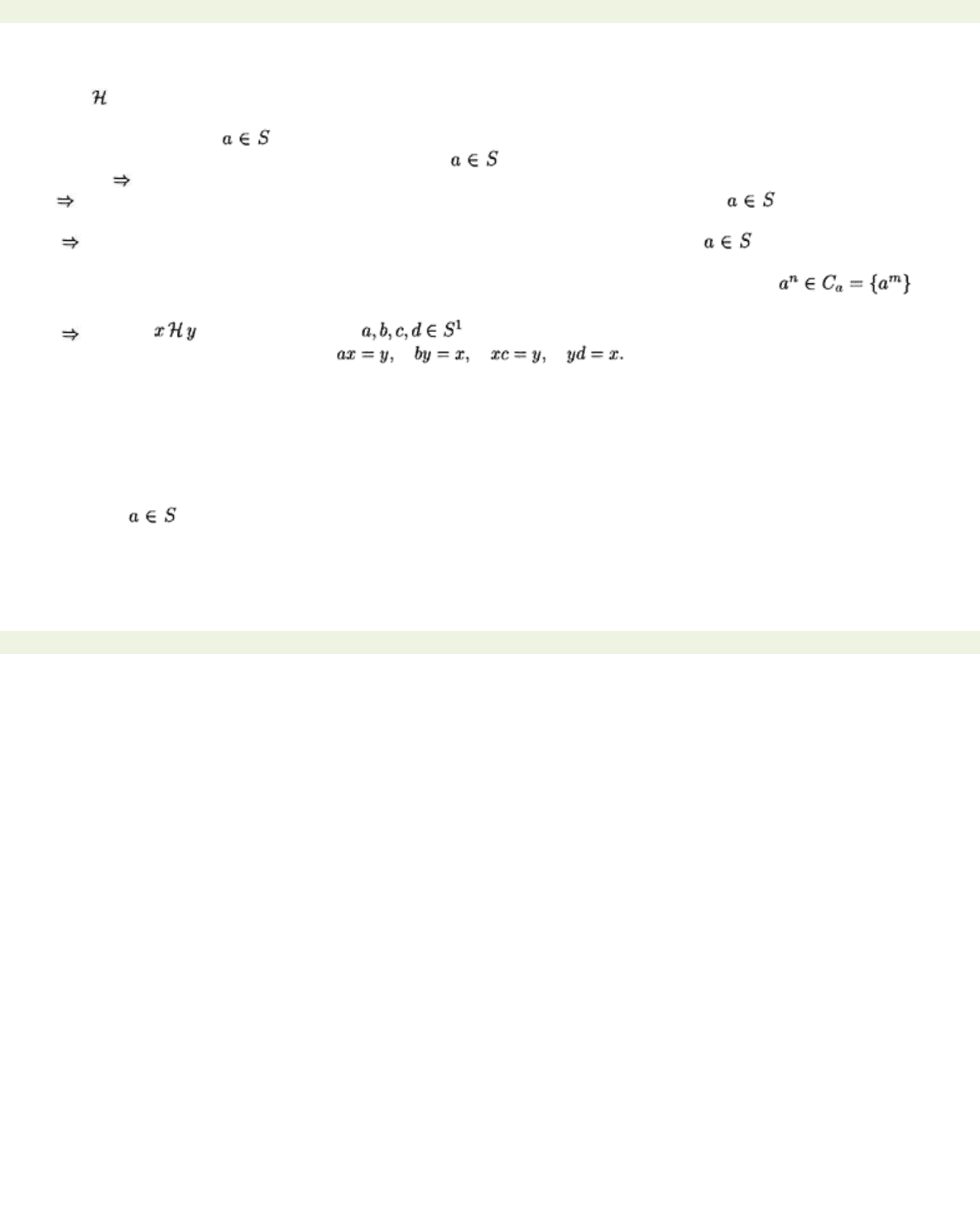
< previous page page_251 next page >
Page 251
Theorem 11.3.2
Let S be a finite semigroup. Then the following are equivalent:
(i)
The relation is equality.
(ii)
The maximal subgroups in S are trivial
(iii)
For each element the period of a is
1.
(iv)
There exists n
>0
such that an
=
an
+1
for all
.
Proof (i) (ii). Immediate from Proposition 11.2.11.
(ii)
(iii). Suppose that the maximal subgroups of
S
are trivial. Then for each the group
Ca,
defined in the proof of Theorem 11.3.1, must be trivial. Hence each element has period 1.
(iii)
(iv). Suppose that each element of
S
has period 1. Let
n
=|
S
| and let . We claim that
an
=
an
+1. Observe that the
n
+1 elements
a, a
2
,…, an
+1 cannot all be distinct. Thus the index of
a
is at
most
n
. If the index of
a
is
n
then the result is immediate. If the index is
m
<
n,
then .
Thus
an=an
+1
(iv)
(i). Let . Then there exist such that
We can therefore write
x
=
axd
and so
x
=
anxdn
for all
n
≥1. By assumption, we can choose
n
such that
an
=
an
+1. Then
ax=a(anxdn)
=
an
+1
xdn
=
anxdn
=
x
. Thus
ax
=
x
. But
ax
=
y
as well. We have proved that
x
=
y
.
A semigroup
S
is
aperiodic
if every group in
S
is trivial. If the semigroup is a subsemigroup of a full
transformation monoid, we can use Proposition 11.2.15 to determine if it is aperiodic. Here is an
alternative algorithm using Theorem 11.3.2.
Algorithm 11.3.3 Let
S
be a finite semigroup.
(1) Choose
and calculate the subsemigroup
a
+.
(2) There are now several cases:
• If the period of
a
is not 1 then
S
is not aperiodic and the algorithm terminates.
• If the period of
a
is 1 and
S
=
a
+ then
S
is aperiodic and the algorithm terminates.
• If the period of
a
is 1 and
S
≠
a
+
,
then we replace
S
by
S
\
a
+ and repeat (1).
< previous page page_251 next page >

< previous page page_252 next page >
Page 252
A detailed analysis of the problem of determining whether a monoid is aperiodic or not is the subject of
[26]. Our next result summarises some important properties of aperiodic monoids.
Theorem 11.3.4
Let S and T be monoids.
(i)
If S is aperiodic and T is a submonoid of S then T is aperiodic.
(ii)
If S is aperiodic and T is a homomorphic image of S then T is aperiodic.
(iii)
If S is aperiodic and T is a monoid dividing S then T is aperiodic.
(iv)
If S and T are aperiodic then S
×
T is aperiodic
.
(v)
If S and T are aperiodic then
is aperiodic.
Proof (i) By assumption
S
contains only trivial groups. It is immediate that
T
can only contain trivial
groups.
(ii) Let
θ: S
→
T
be a surjective monoid homomorphism. Let . Then there exists such that
θ(s)
=
t
. By assumption, there exists
n
>0 such that
sn
=
sn
+1. But
θ(sn)
=
tn
and
θ(sn
+1
)
=
tn
+1. Thus
tn
=
tn
+1. It follows that
T
is aperiodic by Theorem 11.3.2.
(iii) This is immediate by (i) and (ii) above.
(iv) A group in
S
×
T
is of the form
G
×
H
where
G
is a group in
S
and
H
is a group in
T
by Question 9 of
Exercises 11.2. Thus
S
×
T
is aperiodic if
S
and
T
are.
(v) This follows from Proposition 11.2.16 and Question 9 of Exercises 11.2.
Exercises 11.3
1. Find the index and period of each element in
T
3.
11.4 Schützenberger’s theorem
In this section, we shall characterise star-free languages by means of their syntactic monoids. The proof
of the theorem is in two parts: first, if
L
is star-free, then its syntactic monoid
M(L)
is aperiodic; second,
if
L
is a recognisable language with an aperiodic syntactic monoid
M(L),
then
L
is star-free. The proof of
the first half is now easy.
Theorem 11.4.1
The syntactic monoid of a star-free language is aperiodic.
Proof Let
A
be a finite alphabet. The star-free languages are constructed from the basic languages
, ε
and
a,
where
,
using the Boolean operations and product of languages. It is easy to check that the
syntactic monoids of the basic languages are aperiodic. Our induction hypothesis is that any
< previous page page_252 next page >

< previous page page_253 next page >
Page 253
language described by a star-free, generalised regular expression with at most
n
operators has an
aperiodic syntactic monoid. Let
r
be a star-free generalised regular expression with
n
+1 operators. Then
r
=
s′
or
r
=
s
+
t
or
r
=
s
n
t
or
r
=
s
·
t
. Each of the star-free expressions
s
and
t
has at most
n
star-free
operators. Thus the syntactic monoids of
L(s)
and
L(t), M
and
N,
respectively, are both aperiodic. We
now prove in each case that the syntactic monoid of
L(r)
is aperiodic. If
r
=
s′
then
L(s)
recognises
s′
by
Proposition 10.2.8(i); in fact, in this case
L(s)
is also the syntactic monoid of
s′
. Thus
L(r)
has a
syntactic monoid that is aperiodic.
If r
=
s
+
t or r
=
s
n
t
then
L(r)
is recognised by
M
×
N
. But
M
×
N
is
aperiodic by Theorem 11.3.4(iv), and the syntactic monoid of
L(r)
divides
M
×
N
by Theorem 10.2.6,
consequently by Theorem 11.3.4(iii), the syntactic monoid of
L(r)
is aperiodic. Finally, if
r
=
s
·
t
then
L(r)
is recognised by a monoid
S,
which is a subsemigroup of by Proposition 10.2.11. But is
aperiodic by Theorem 11.3.4(v), and so
S
is aperiodic by Theorem 11.3.4(i). The syntactic monoid of
L(r)
divides
S
by Theorem 10.2.6, consequently by Theorem 11.3.4(iii), the syntactic monoid of
L(r)
is
aperiodic. It follows that in all cases the syntactic monoid of
L(r)
is aperiodic.
The result above is already useful.
Example 11.4.2 Let
A
=
{a}
. A recognisable language
L
over
A
has the form
L
=
X
+
Y(ap)
* where
X
and
Y
are finite languages. We claim that
L
is star-free if and only if
p
=0, 1. If
p
=0, 1, then we established
that
L
is star-free in Section 11.1. We shall now prove that if
p
≥2 then
L
is not star-free. To do this, we
shall prove that the syntactic monoid of
L
is not aperiodic, which gives the required result by Theorem
11.4.1. As we saw in the proof of Theorem 5.2.2, the minimal automaton A for
L
consists of a stem, and
a cycle of
p
states
r
1
,…, rp
. It follows that the letter
a
induces a non-trivial permutation on the set
{r
1
,
…, rp}
. Consequently, the transition monoid of A contains a non-trivial group by Proposition 11.2.15(iii).
But the transition monoid of the minimal automaton of
L
is isomorphic to the syntactic monoid of
L
by
Theorem 9.4.3. It follows that the syntactic monoid of
L
is not aperiodic, and so
L
is not star-free by
Theorem 11.4.1.
From this result, it follows that the language
(aa)
* is not star-free. This should be contrasted with the
language
(ab)
*
,
which we explicitly showed to be star-free in Example 11.1.1.
The proof of the converse, that an aperiodic syntactic monoid implies a star-free language, is much
harder in the case of a general alphabet and we shall need a number of preparatory steps.
Lemma 11.4.3 (Cancellation property)
Let M be an aperiodic monoid. Suppose
are such
that q
=
pqr
.
Then q
=
pq
=
qr
.
< previous page page_253 next page >

< previous page page_254 next page >
Page 254
Proof The monoid
M
is aperiodic, and so by Theorem 11.3.2 there is a positive integer
n
such that
an
=
an
+1 for each . From
q
=
pqr
we get by induction that
q
=
pnqrn
. Thus
q
=
pn
+1
qrn
=
p(pnqrn)
=
pq
. A similar argument shows that
q
=
qr.
Lemma 11.4.4
Let M be a monoid, and . Put
Then W(a) is the largest ideal in M that does not contain a.
Proof Suppose that
W(a)
is empty. We prove that every non-empty ideal of
M
contains
a
. Let
I
be a
non-empty ideal of
M
and let . Then . If then
,
but this contradicts the
assumption that
W(a)
is empty. Thus and so .
Suppose that
W(a)
is non-empty. Let and let . We show that . If
then from we get that
,
which is a contradiction. Thus
. We may similarly show that and it follows that
W(a)
is an ideal. We now prove
that
W(a)
is the largest ideal in
M
not containing
a
. Let
I
be a non-empty ideal of
M
that does not
contain
a
. Let . Then
,
because
I
is an ideal. Since
I
does not contain a neither can
MbM
.
It follows that . Hence .
We now have the following crucial property of aperiodic monoids.
Proposition 11.4.5
Let M be an aperiodic monoid. Then
for each .
Proof From Lemma 11.4.4, the element a belongs to the complement of
W(a)
in
M,
and it is evident
that . Thus the left-hand side is always contained in the right-hand side. To prove the
reverse containment, let . Then
b
=
ap
=
qa
and
a
=
ubv
for some . Then
a
=
ubv
=
(uq)av,
and so by the cancellation property
a
=
uqa
=
av
. Thus
a
=
ub
=
uap
and so by the
cancellation property
a
=
ua
=
ap
. Hence
a
=
b,
as required.
Suppose that
L
is a language whose syntactic monoid is aperiodic. In particular, there is a monoid
homomorphism
,
where
M
is aperiodic and a subset such that . We can
therefore write . So to show that
L
is star-free it is enough to prove that languages of
the form
are star-free, and this will be the approach we adopt.
< previous page page_254 next page >
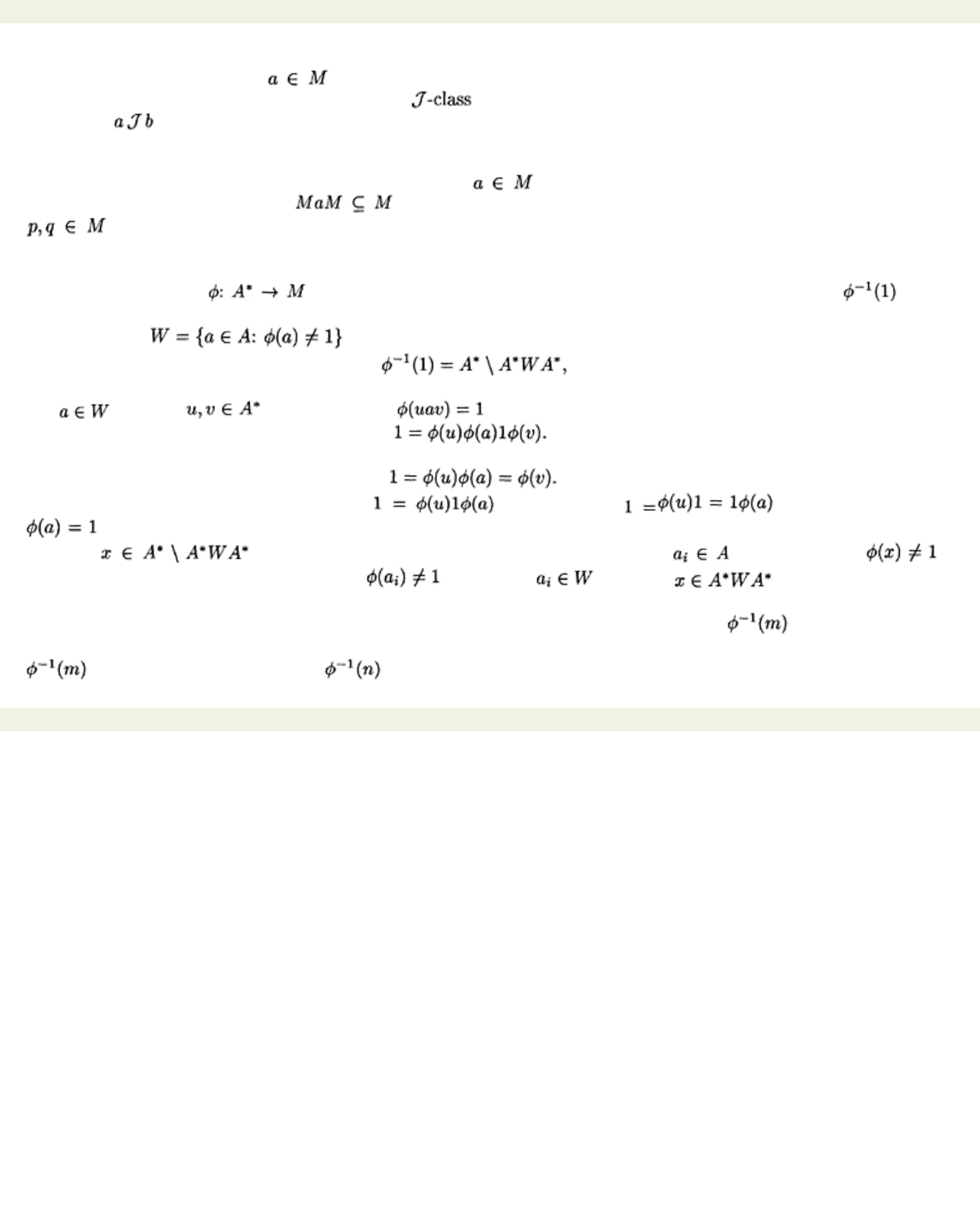
< previous page page_255 next page >
Page 255
Let
M
be a monoid and let . By the
rank of a,
denoted r
(a),
we mean the number |
MaM
|. If two
elements
a
and
b
of
M
belong to the same , then they must have the same rank, because by
definition
means that
MaM
=
MbM
. Since
MaM
is a subset of
M,
the largest the rank can be is |
M
|.
This is reached by the identity because
M
1
M
=
M
2=
M
. In an aperiodic monoid, the identity is the only
element reaching maximum rank, as we now show.
Lemma 11.4.6
Let M be an aperiodic monoid. If is such that
r
(a)
= |
M
|,
then a
=1.
Proof From |
MaM
|=|
M
|, and we have that
M
=
MaM
because
M
is finite. Thus there are
such that 1=
paq
. From 1=
(pa)
1
q
and the cancellation property for aperiodic monoids, we
have that 1=
pa
=
q
. And from 1=
p
1
a
we get 1=
p
=
a
by the cancellation property.
The next result tells us that for the element of maximum rank, the inverse image will be star-free.
Lemma 11.4.7
Let be a monoid homomorphism to an aperiodic monoid. Then
is a
star-free subset of A
*.
Proof Define
. We claim that
which is clearly star-free.
Let
and let . Suppose that , so that
By the cancellation property for aperiodic monoids, we have that
By the cancellation property applied to we have that . Thus in particular
, which is a contradiction. Hence none of the strings in
A
*
WA
* can be mapped to 1.
Now let be a non-empty string. Then
x
=
a
1
…an
where . Suppose that .
Then for at least one
i,
we must have . But then
,
and so , which is a
contradiction. We have therefore proved the result.
In order to prove our main theorem, it remains therefore to prove that the set
is star-free for
each element
m
of our monoid, which is not of maximum rank. Our approach will be to write the set
as a ‘combination’ of sets where the rank of n is strictly greater than the rank
< previous page page_255 next page >
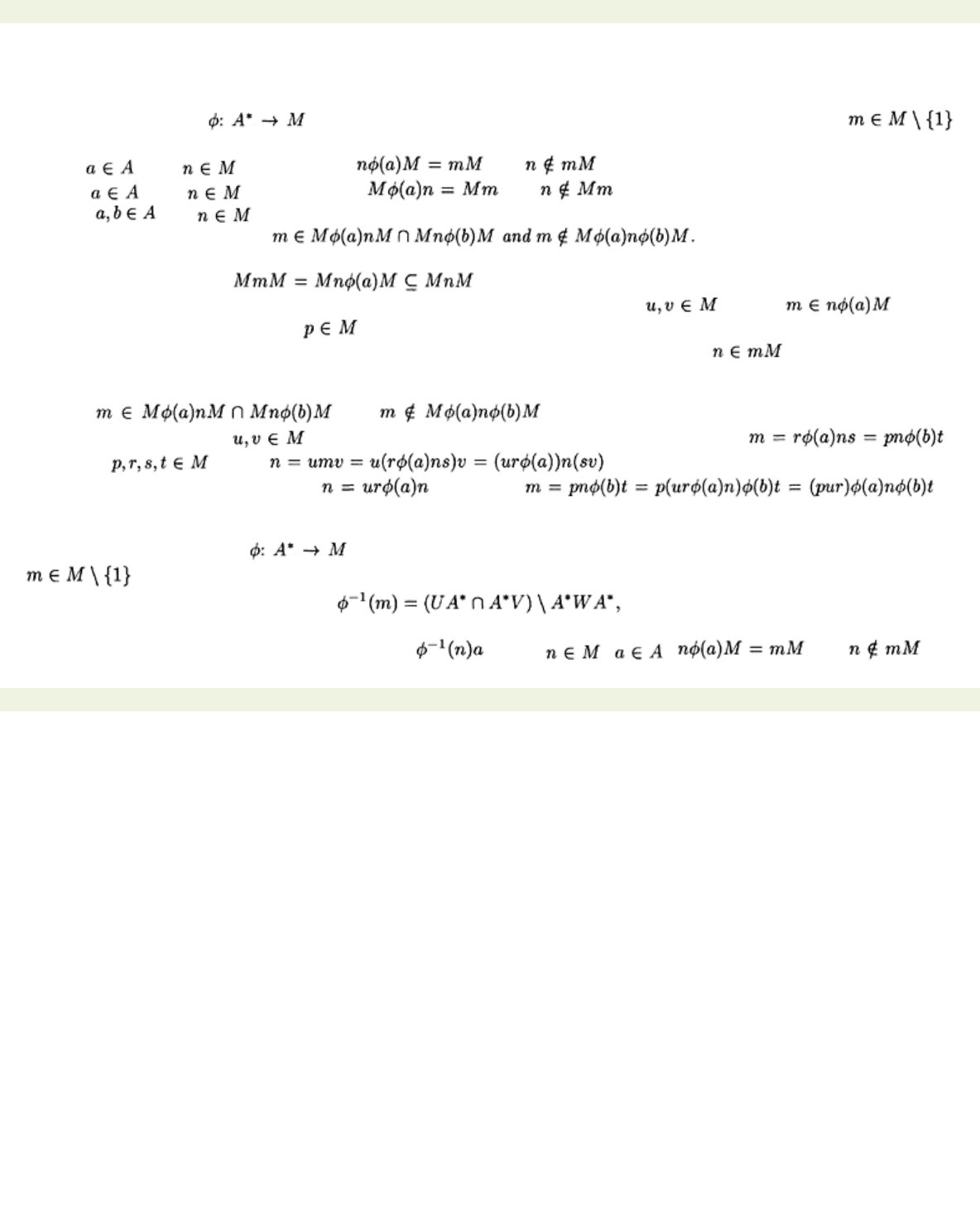
< previous page page_256 next page >
Page 256
of
m,
and where by ‘combination’, we mean using only Boolean operations or concatenation.
The following is a technical lemma whose significance will soon become clear.
Lemma 11.4.8
Let be a monoid homomorphism to an aperiodic monoid M. Let
.
(i)
Let
and
be such that
and
.
Then
r
(n)
>r
(m)
.
(ii)
Let and be such that
and
.
Then
r
(n)
>r
(m)
.
(iii)
Let
and
be such that
Then
r
(n)
>r
(m)
.
Proof (i) Observe that
,
so that r
(m)
≤r
(n)
. Suppose that r
(m)
=r
(n)
. By
finiteness,
MmM
=
MnM
. It follows that we can write
n
=
umv
for some . Since
,
we
also have that
m
=
np
for some . Thus
n
=
umv
=
un(pv)
. By the cancellation property for aperiodic
monoids, we therefore have that
n
=
un
=
npv
. Thus
n
=
mv,
which implies that . But this is a
contradiction. It follows that r
(n)
>r
(m)
as required.
The proof of (ii) is simply the left-right dual of the proof of (i).
(iii)
Let
and . Clearly r
(m)
≤r
(n)
. Suppose that r
(m)
=r
(n)
.
Then
n
=
umv
for some . In addition, we have from our assumptions that
for some . Now . Thus by the cancellation property for
aperiodic monoids, we have that . But then
,
which contradicts our assumptions. It follows that r
(n)
>r
(m),
as required.
The key argument in our proof of Schützenberger’s theorem is the following.
Proposition 11.4.9
Let be a monoid homomorphism to an aperiodic monoid M. Let
. Then
where U, V and W are subsets of A
*
defined as follows:
•
The set U is the union of sets of the form
where , ,
but
.
< previous page page_256 next page >
